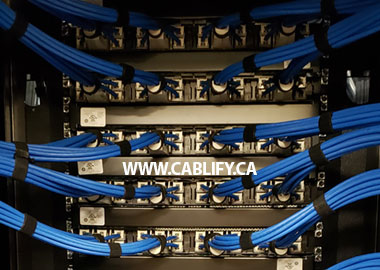Cat6 cabling is the most popular Network Cable widely used in offices, new buildings, warehouses and other commercial businesses, This is a type of Ethernet cable that is used for high-speed data transmission over a network. It is a twisted-pair cable that is made up of four pairs of copper wires, each of which is used to transmit data. The wires are twisted together to reduce crosstalk, which is the interference between different data signals transmitted on the same cable.
Cat6 Cable Bandwidth
The bandwidth of a Cat6 cable refers to the maximum amount of data that can be transmitted over the cable in a given period of time. Bandwidth is measured in MHz (megahertz) and is a measure of the cable’s data-carrying capacity. The higher the bandwidth, the more data that can be transmitted, and the faster the data transfer speeds.
In the case of Cat6 cable, the bandwidth is specified to be up to 250 MHz compared to 100 MHz for Cat5 and Cat5e. This means that the cable is capable of transmitting up to 250 million cycles of data per second. This higher bandwidth, compared to earlier Ethernet cables like Cat5 and Cat5e, allows Cat6 cable to support faster data transfer speeds and handle more data-intensive applications, such as video streaming and online gaming. Cat6 cable also uses improved cable design, such as tighter twists and thicker shielding, to reduce crosstalk and provide a more stable and reliable network connection. It is also commonly used in high-speed network connections, such as 10 Gbps Ethernet, to support the transmission of large amounts of data.
Cat6 Cabling Crosstalk
Crosstalk is a type of interference that occurs in data cabling, particularly in Ethernet cables. It occurs when the electrical signals of one data channel interfere with the signals of another channel that is transmitted on the same cable. Crosstalk can cause errors in the transmitted data and can slow down data transfer speeds, leading to decreased network performance.
Crosstalk is particularly problematic in high-speed network connections, where high frequencies are used to transmit large amounts of data. When two channels are transmitting data on the same cable, the electrical signals of one channel can interfere with the signals of the other channel, causing crosstalk. This interference can cause errors in the transmitted data, leading to decreased network performance.
To reduce crosstalk, Ethernet cables use a number of design features, such as tight twists, thicker shielding, and improved insulation, to keep the electrical signals of different channels separate and prevent interference. Improved cable design can help reduce crosstalk and provide a more stable and reliable network connection.
Cat6 cable was also designed to reduce crosstalk, which is the interference between different data signals transmitted on the same cable. Crosstalk can cause data errors and slow down data transfer speeds, so reducing crosstalk is critical to achieving fast and reliable network connections. Cat6 cable uses improved cable design, such as tighter twists and thicker shielding, to reduce crosstalk and provide a more stable and reliable network connection.
Cat6 cable data transfer rate and length limit
The data transfer rate of a Cat6 cable depends on several factors, including the quality of the cable, the network equipment used, and the type of data being transmitted. However, Cat6 cable is specified to support data transfer rates of up to 10 Gbps (gigabits per second) over a distance of up to 55 meters (180 feet). This is significantly faster than earlier Ethernet cables like Cat5 and Cat5e, which supported data transfer rates of up to 100 Mbps (megabits per second).
It’s important to note that the actual data transfer rate will depend on a number of factors, including the quality of the cable, the network equipment used, and the type of data being transmitted. However, the higher data transfer rate and improved signal quality of Cat6 cable make it a popular choice for businesses and homes that require fast and reliable network connections.
In terms of length limit, the maximum recommended length for a Cat6 cable is 100 meters (328 feet) for most applications. However, for some high-speed data applications, such as 10 Gbps Ethernet, the maximum recommended length may be shorter, typically around 55 meters (180 feet). To ensure reliable network performance, it’s important to use high-quality Cat6 cable and follow the manufacturer’s recommendations for cable length and installation.
Cat6 Cable interference
Cat6 cable is designed to better handle interference compared to earlier Ethernet cables, such as Cat5 and Cat5e. This is achieved through several design improvements that reduce crosstalk, minimize EMI and RFI, and improve signal quality. Cat6 cable uses a tighter twist in the wire pairs, which helps to reduce crosstalk and minimize interference between different data signals transmitted on the same cable. Additionally, Cat6 cable has a thicker shielding layer, which helps to reduce the effects of EMI and RFI. Cat6 cable uses improved cable design, such as tighter twists and thicker shielding, to reduce crosstalk and improve signal quality. This helps to ensure that the electrical signals transmitted over the cable are stable and reliable, reducing the chances of errors or lost data.



